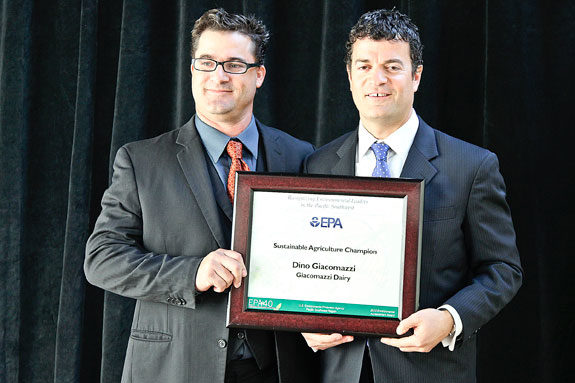The California dairy silage sector has increased its acreage the most dramatically under conservation tillage, says Jeff Mitchell, a cropping systems specialist at the University of California – Davis.
Every two years, the university conducts a survey about conservation tillage management. Mitchell says that over the past six years, the use of conservation tillage in the California dairy silage sector has increased from 2 percent to almost 20 percent.
Dino Giacomazzi, a dairy farmer from Hanford, California, has become one of the leaders in this movement towards conservation tillage.
He received the Sustainable Agriculture Champion award from the Environmental Protection Agency (EPA) for his experiments and progress using strip tillage on his farm.
“It’s great to see that the EPA is endorsing this type of farm practice as sustainable. Some people have different ideas about what sustainable is supposed to mean, so they’re trying to define sustainable as things like organic, when in reality, those things aren’t very sustainable at all,” Giacomazzi says.
Giacomazzi began looking into using conservation tillage when his father applied for a grant from the NRCS that required the recipient to find ways to reduce dust in their farming practices.
This was the beginning of years of research and trial-and-error. Giacomazzi did his first experiment in 2003, and in 2004, he used strip-till for the first time.
“When I started this thing, there were very few people doing it, so I didn’t have a lot of people to learn from their mistakes. Although I did have a few, I kind of had to go out and make my own mistakes,” Giacomazzi says.
One of the biggest mistakes that people make when they first start out is failing to realize that changing to strip tillage requires changes in the whole production system, Mitchell says.

People often fail to plan and prepare ahead of time. Changes include the irrigation system, timing of planting, water management and pest control.
“It takes tenacity and planning foresight to really start integrating all the pieces of the thing. It’s not just the sequential operations throughout the year. It’s putting the whole system together in a way that makes sense,” Mitchell says.
Mitchell says that Giacomazzi has “true systems thinking,” but Giacomazzi admits that he learned this the hard way. He found that he had to change his whole system to make strip-till work on his farm.
For example, Giacomazzi has found that he has to time his planting to take advantage of the moisture held in the soil. Once the soil is dry, he can’t till it to find moisture for the seed.
Over the years, Giacomazzi has found that what works for another operation doesn’t necessarily work for his. He developed five criteria that he has used to evaluate his conservation tillage system as he’s put it together.
The criteria state that a system needs to be economically sustainable, increase yield, improve soil quality, reduce inputs and reduce emissions.
Strip tillage requires modified equipment that is a little different than conventional equipment. Giacomazzi converted some of his equipment, but he also has been working with the University of California – Davis and using their equipment for the last five years.
Giacomazzi only has 60 percent of his property under the strip-till system, but is planning to convert all his property to strip-till, so he is looking to buy his own equipment. He says that he can pay for most of the new equipment by selling the old machinery.
“It’s pretty inexpensive to switch over. You have all the savings in fuel and later all the expenses you would have incurred before can go toward paying off the equipment.
I think that as long as you can follow a program and are conscientious about management, you can switch to strip-till without losing yield. And as long as you don’t lose yield, it pays for itself,” Giacomazzi says.

Giacomazzi was not only able to maintain yield when he converted to strip-till, he was able to increase it. Last year, his strip-till corn yielded five more tons of silage per acre than his conventional fields did. Along with the yield increase, Giacomazzi found that his soil was much improved as well.
“Harvest compaction hasn’t been much of a problem because after a few years, the ground builds up a certain amount of organic matter, and the different biological activity tends to create this sort of spongy consistency.
Over the last couple of years, when the trucks go through the field, within a week or two, you can’t find any tracks. It’s kind of sprung back. But it takes a couple of years to get to that,” Giacomazzi says.
Because of the increased organic matter and biological activity, Giacomazzi is considering eventually converting to a no-till system.
For those considering a strip tillage system, Giacomazzi says, “The most important thing to look at first is your regular system. Look at the type of soil you have, because not every soil is suited for strip tilling.
Look at your irrigation systems, because not every type of irrigation is conducive to it. I would also say to look at all of the steps and processes involved and try to understand the whole system before you start. Have a plan, a written-out plan, that someone can help you out with.” FG
PHOTOS
TOP: Dino Giacomazzi receives the Sustainable Agriculture Champion award from the Environmental Protection Agency (EPA) for his experiments and progress using strip tillage on his farm.
MIDDLE: One of the biggest mistakes people make when they first start out is failing to realize that changing to strip tillage requires changes in the whole production system. People often fail to plan and prepare ahead of time.
BOTTOM: Farmers wanting to learn more about conservation tillage can go to the farm for a tour of the fields and ask questions about what the Giacomazzis have done on their farm. Photos courtesy of Dino Giacomazzi.













